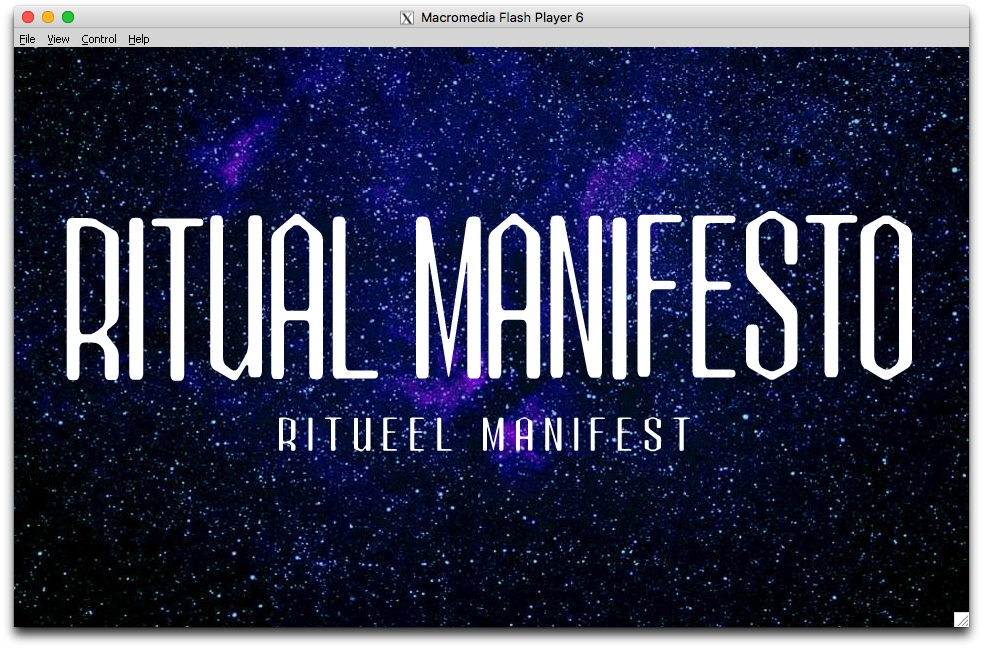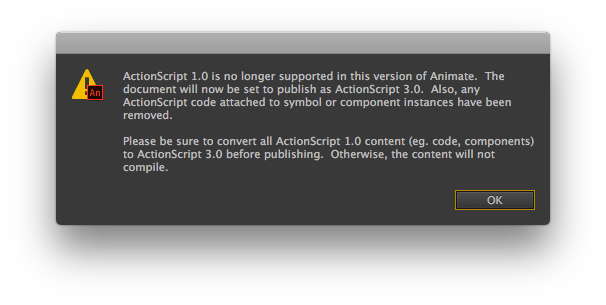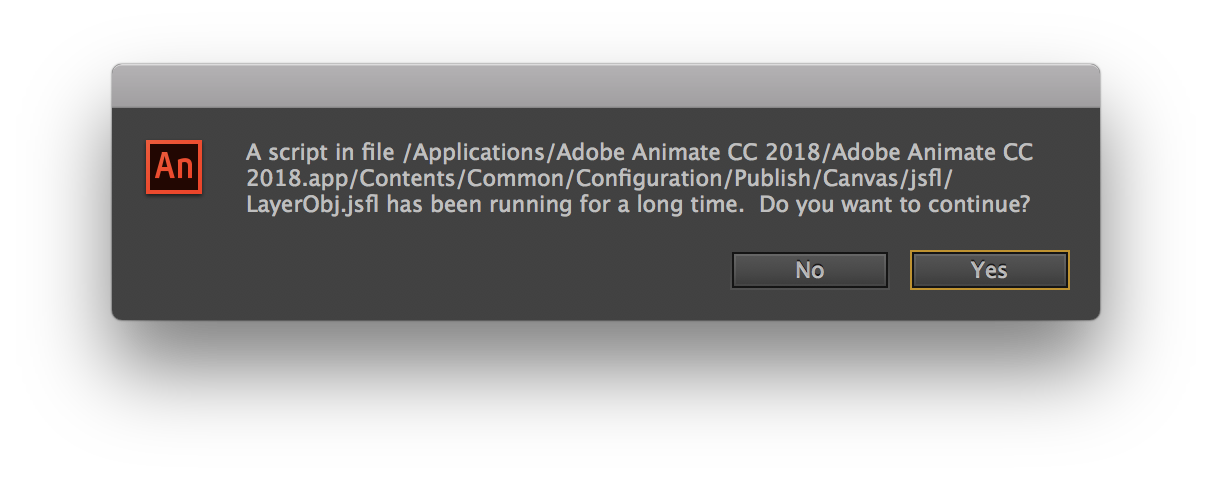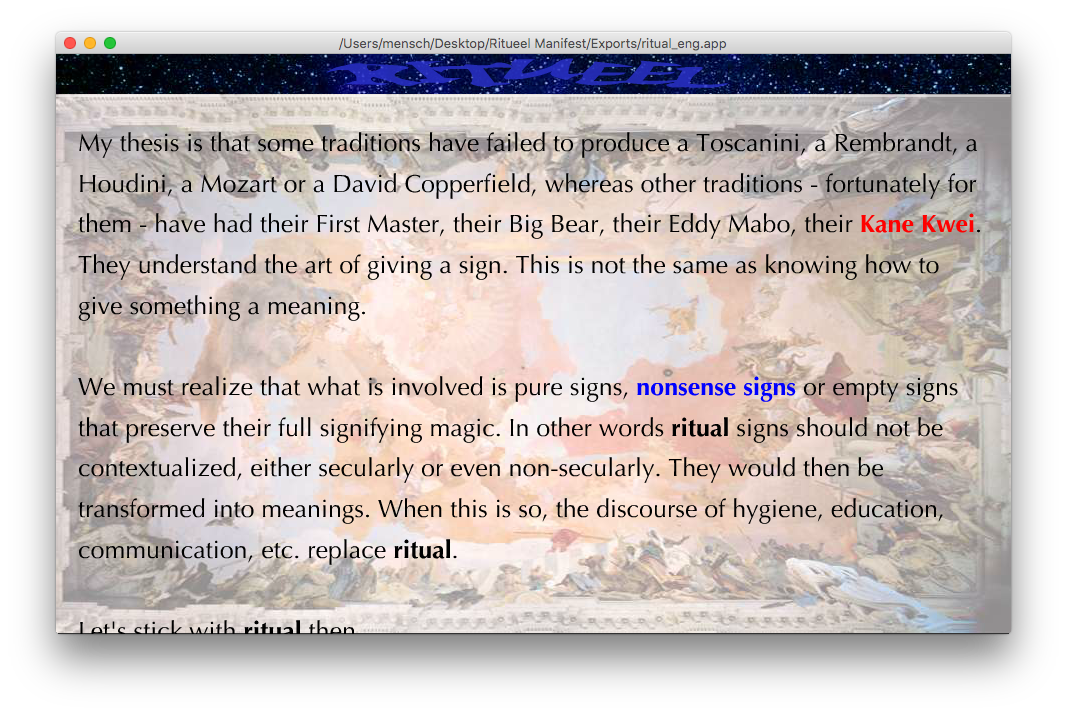Ritual Manifesto is a digital publication by author Agnes Schreiner and published by Uitgeverij 1001 (Thousand & One Publishers) in 2003. This so-called web edition was built by Machined Arts using Adobe Flash and distributed via the web1 and on CD-ROM. In the summer of 2017, Adobe Systems announced that it would end support for Flash Player in 2020. This document details the attempts to convert the Ritual Manifesto to a file format viewable on modern hardware and to extract the assets for possible re-use.
Unpacking a projector
While Machined Arts was scouring their archives to find the source files for the project, I started working on the files, ripped from a CD-ROM, provided by Uitgeverij 1001. Sadly, the web version of the project is no longer online, which would have been a better starting point than the projector available on the CD-ROM. A Flash projector is a standalone package which allow someone to view a Flash movie or application without having the official player installed. Projectors have to be built for Windows and macOS specifically and cannot run cross-platform.
The projector from the CD-ROM was a Windows binary, which means it doesn’t run on macOS without jumping through a few hoops. Running Windows software on macOS is possible through the use of Wine2. The compatibility layer is capable of running complex software like Microsoft Word3 or modern games like The Elder Scrolls: Skyrim. 4 Using a tool called WineSkin5, which creates macOS application bundles using wine, I was able to run the projector.

Ritual Manifesto running on macOS High Sierra
As projectors are self-contained packages which cannot be unpacked by normal means. Using a tool called eXeToSwF (Windows-only, so run in a wine wrapper)6 I was able to extract three SWF files from the projector. The ShockWave Flash (SWF) file format is traditionally used by the Flash player for the desktop and in web browsers that support the player plugin. Adobe released the file specification for SWF as part of their Open Screen Project to allow for indexing by search engines and support by third-party applications. 7 As such it’s easier to manipulate the SWF format. The Unarchiver, 8 a data decompression utility, is able to unpackage SWF files, allowing the user to extract images and sounds from a file. There were also three initiatives to convert the SWF format to the modern web, without the need for the official Flash player. Mozilla Shumway9 was an HTML5 renderer for SWF files, while Adobe Wallaby10 and Google Swiffy11 offered to convert SWF to HTML5, possibly allowing to tinker with the resulting source code. All solutions were originally created to allow mobile devices to display Flash content, but after the sunsetting of Flash, the projects were abandoned.
The Source
In the meantime, Machined Arts found the Flash source files for the project. While it’s theoretically possible to convert SWF files back to the FLA format, using third-party tools, working with the original source is of course the preferred method. Adobe’s authoring software Flash Professional was discontinued in 2015, 12 13 foreshadowing the 2017 decision to sunset Flash in the near future. The replacement software Animate CC is primarily focussed on animation and the support of web standards (HTML5, WebGL) instead.
Flash incorporated its own scripting language called ActionScript which went trough several versions and many changes until version 3.0 in 2006. Ritual Manifesto was scripted using ActionScript 1.0, which results in the warning dialog as pictured below…

Outdated ActionScript warning
Any ActionScript 1.0 will fail to compile when republishing with Animate CC, unless the code is manually converted to the latest version of ActionScript. Another problem with the file is the missing fonts (Atomic Sans and Optima Sans). The file can be opened ignoring both warnings, but it messes up the text and the outdated ActionScript causes the possible loss of scripted interactivity.
With Animate CC it’s possible to convert a project to an HTML5 Canvas14 or a WebGL15 object, which are both open technologies. Actually publishing Ritual Manifesto as a HTML5 Canvas or WebGL object is another matter. The publishing procedure hangs on several export scripts and is ultimately unable to complete. The resulting files mostly resemble glitchy net art when run from a browser.
Creating a projector with Animate CC results in the same behavior and a lot of compile errors, so likely the deprecated version of ActionScript is to blame for most of the problems.

Animate CC script error when exporting as HTML 5 Canvas
The manifesto could likely be restored by hand in Animate CC, but that’s not the purpose of this experiment.
Application archeology
 After delving into the Adobe website, I was able to find older versions of their Creative Suite, which has traditionally included Flash Professional after Adobe Systems took over the original creators of the software: Macromedia. I installed a trial version of Adobe Flash Professional CS6, the last version before Adobe switched to their Creative Cloud subscription model in 2012. 16 The software isn’t sold anymore since 2017, 17 so only existing serial numbers work or you’re limited to trial run of thirty days, after which you’re unable to use the software entirely.
After delving into the Adobe website, I was able to find older versions of their Creative Suite, which has traditionally included Flash Professional after Adobe Systems took over the original creators of the software: Macromedia. I installed a trial version of Adobe Flash Professional CS6, the last version before Adobe switched to their Creative Cloud subscription model in 2012. 16 The software isn’t sold anymore since 2017, 17 so only existing serial numbers work or you’re limited to trial run of thirty days, after which you’re unable to use the software entirely.
Flash CS6 opens the original FLA of the manifesto without complaining about ActionScript. The missing fonts are obviously still an issue. Unfortunately, CS6 lacks the ability to convert FLA to HTML5 like Animate CC does. Wallaby was created to serve that purpose, as mentioned earlier, but the application lacked support for a large swatch of features available in Flash. 18 The only options available in CS6 are exports to SWF and OS-specific projectors. Using the projector option I was able to create a working macOS projector, that appears to be largely identical to the original Windows version, except for the text that has shifted due to the missing fonts.

Newly created Mac projector showing one of the text screens
Concluding
While it’s still possible to ‘rescue’ existing Flash content, the process is time-consuming and requires a lot of manual labour. There are tools to claim to convert SWF back to FLA, 19 but they’re likely work as well as Adobe’s official conversion procedures available in their latest software suite.
Luckily, rescuing assets from Adobe’s proprietary, self-contained file formats still seems possible, due to their release of the file specification. When converting or extracting assets, the publishing concept of the in Ritual Manifesto is lost in the process, however.
—————


